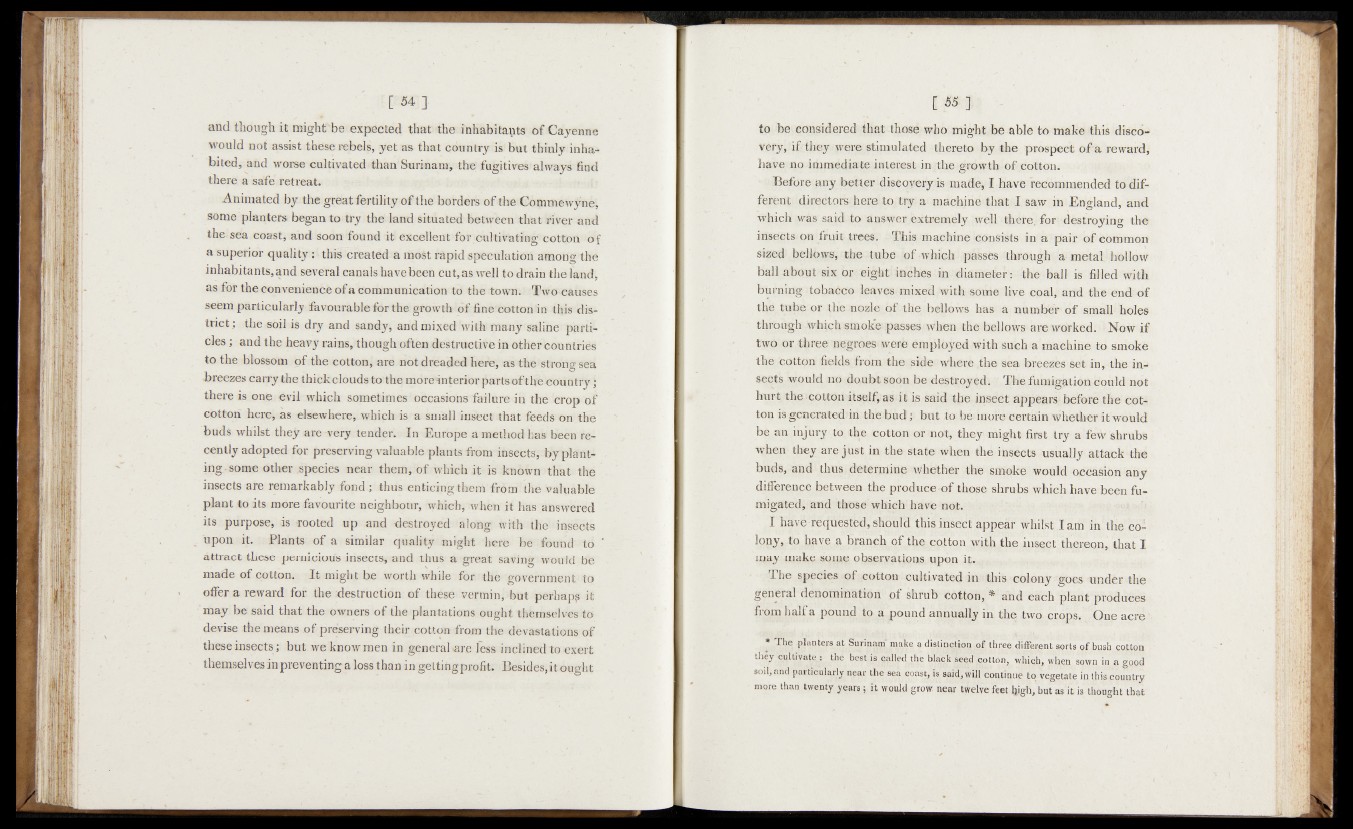
and though it mighrbe expected that the inhabitants of Cayenne
would norf .assist these Fdbel^V ^ e tm that cdantryiifc but thinly inha^
bited, ahd worse cultivated than Suiinara, thefugitives?always find
there a safe retreat.
Animated by. the great fértifityofthebotders of the Commewyne,
some planters began to tty the land situated between that iiver and
the-séa coast, and Soon found id excellent for cultifetin^eotton '!^f
a superior quality: this created a moét rèpid speculation among'thé
inhabitants, and several canals have been cut, as well to drain the land,
as fot the convenience of a communication to the town.; Twöeauses
seem particularly fevourable for the gtowth of fine eottoniin this district;
the soil is dry and sandy, and mixed 'with many saline partied
8 i and the heavy rains, though often destructive in other countries
to the-blossom pfifhe cotton» are not dreaded here, as the strong sea
breezes canty the thicfcolouds to the mdre^nterior ^arlsofthecoUfit^y f
there is one evil which sometimes occasions failure-in the crop of
cotton here, as elsewhere, which is a small insect that feeds on thé
buds whilst they are -very tender. In Europe areetlmd has tieèn IV
cently adopted for preserving valuable plants from insects» by plant-
ing-some other species near them,-of which it. is known that t « *
insects are remarkably fond; thus en ticing them fr^m the WüabÉê
plant to its more favourite neighbour, which, when it has answered
its purpose, is tooted up and destroyed ;along With the imsééts
upon it. ' Plants of a similar quality m igh t • IterA "bé- • fcttfldPtd
attract these pernicious insects, and thus? a great saving would be
made of cotton. It might be worth while for the government to
offer a reward for. the destruction of these vermin, but perhapf it
may be said that the owners of the plantations ought thèmselvPs40
devise the means of preserving their cotton from the devastations of
these insects ; but we know men in generalare less inclined to exert
themselves in preventing a loss than in gettihg profit. Besides» it ought
to be considered that those who might be able to make this disco-*
very, :if. they were stimulated thereto by the prospect of a reward,
have no im med iate i nterest i n jthe growth of cotton.
Before any better diseqyerytfs made, I have recommended to different
directors- here: to try a mach-ine* that I; saw in England, and
"which was said to answer extremely well -there, for- destroying the
insects on fruit trees. - This machine ieonSists in a pair of common
si^ed bellows, the tube |pf -which paSses «through a metal hollow
ball about six OKé^trifiches in diameter : the ball is filled with
b um in ^ t^ a ceo leaves; mixed with-some liye coal, and theend of
the tube;.-o|>-|)^|M‘o^e|hff4he;‘betoog has a number of sraalb holes
through which smoke-passes when the bellows are worked. * Now if
two or three negroes -wore employed with such a machine to smoke
■; the in-*
sects would no doubt soon be destroyed: The fumigation could not
hur|f5theicottori itself»?as?it is said the insect appears before tire cotton
is generated in thebudj: but to be more certain whether it'would
be an injury to the cotton or not, they might* first try a fe^v shrubs
when they are just in the state when the insects usually attack the
buds, and thus determine whether the smoke would occasion any
difference between the produce-of those shrubs whieh have been fumigated,
and those which have not.
I havé-requested, should this insect appear whilst lam in'the co-
have a branch of the cotton wijth the insect theyeon, that I
may make some obseryaüons upon it. f
The species ofocotton --cultivated in this colony;'go©s -under the
generaldenomination pf shrub cotton, * and each plant produces
from half a pound to a pound annually in the two crops. x One acre’
* The planters at Surinam* m?he a dislioption of, three differ,ent sorts o f bush cofton
they cultivate s thé best'is calledthe black seed cotton, whiqh, when sown in a good
soil, and particularly near the sea coast, is said, will continup to vegetate ip this Country
more than twenty years; it would grow- near twelve feet tygh, but as it is thought that